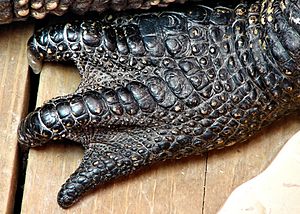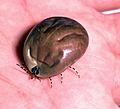Scute facts for kids

A scute is like a tough, bony plate or a hard scale found on the outside of an animal's body. You can see scutes on the shells of turtles, the skin of crocodiles, and even on the feet of some birds. They act like a natural armor, protecting the animal.
What Are Scutes?
Scutes are a lot like scales and do the same job: they protect the animal. But there's a cool difference! Most scales, like those on fish or snakes, grow from the very top layer of skin, called the epidermis.
Scutes, however, grow from a deeper, living layer of skin called the dermis. This means they are often stronger and can even have bone inside them. The top part of a scute is hard and horn-like, similar to a scale.
Scutes with Bone: Osteoderms
Sometimes, scutes have a boney base. These special scutes are called osteoderms. Think of them as built-in armor plates! Many reptiles, like crocodiles and some lizards, have osteoderms.
You can also find scutes on the feet of birds and the tails of some mammals. Scientists believe these bony plates were an early form of natural armor for reptiles.
Other Animals with Scutes
The word "scute" is also used for the heavy armor of animals like the armadillo. It was also used for the extinct glyptodon, which was like a giant armored armadillo.
Sometimes, people even use the term "scute" instead of "scales" for certain fish, like the sturgeon.
Images for kids
-
This detail of a Glyptodon displays its scutes. From the collection of the Children's Museum of Indianapolis.
-
Detail of scutes of a leopard tortoise
-
The Pineconefish
-
The same scutum is relatively less conspicuous after the tick has fed, because it has not changed in size, whereas the tick has swollen as it engorged







